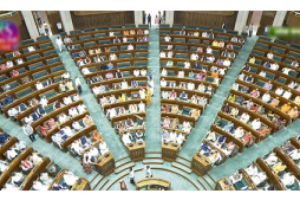The Integrated Rural Development Programme (IRDP) is a grim reminder of how mechanically trying to meet targets can undermine the integrity of a social revolution to such an extent that a counter-revolution can be set into motion. Arguably India’s worst-ever development program, the IRDP, was intended to provide income-generating assets to the rural poor through cheap bank credit. There was little support for skill formation, access to inputs, markets and necessary infrastructure.
In the case of cattle loans, for example, most cattle owners reported that either they had sold off the animals bought with the loan or that the animals were dead. Cattle loans were financed without adequate attention to other details involved in cattle care: fodder availability, veterinary infrastructure, marketing linkages for milk, etc.
The people erroneously believed the state had all the answers to their problems. Governments, international financial institutions and non-governmental organizations (NGOs) threw vast amounts of money at creditbased solutions to rural poverty, particularly in the wake of the World Bank’s 1990 initiative to put poverty reduction at the head of its development priorities.
And yet those responsible for such transfers had, and in many cases continue to have, only the haziest grasp of the unique demands and difficulties of rural banking. Working for the poor does not mean indiscriminately thrusting money down their throats. Unfortunately, IRDP did precisely that. The programe did not attempt to ascertain whether the loan provided would lead to creating a viable long-term asset nor try to make the necessary forward and backward linkages to supply raw material or establish marketing linkages for the produce. Little information was collected on the intended beneficiary.
The IRDP was principally an instrument for powerful local bosses to distribute political largesse opportunistically. The abiding legacy of the programme for India’s poor has been that millions have become bank defaulters through no fault of their own. Today, the people so marked find it impossible to rejoin the formal credit stream.
The IRDP alone accounted for 40 per cent of the losses incurred by commercial banks in rural lending in India. By the end of the 1980s, great concern began to be expressed about public sector banks’ low capital base, low profitability, and the high percentage of non-performing assets, whose earnings were invariably lower than their loan losses and transaction costs. They required continual refinancing and recapitalization by apex institutions.
The final nail in the coffin was the official loan waiver of 1989, which destroyed whatever semblance of credit discipline remained. A one-time provision of credit without follow-up action and a lack of a continuing relationship between borrowers and lenders also contributed to the failure of the programmes. It as thus recommended that all selfemployment programmes be merged, a shift of importance from an individual beneficiary approach to a group-based process. It emphasized the identification of activity clusters in specific areas and robust training and marketing linkages.
The government of India accepted these recommendations. On 1 April 1999, a new programme called Swarnajayanti Gram SwarojgarYojana (SGSY ) was launched by amalgamating programmes like IRDP (Integrated Rural Development Programme) and several allied programmes such as TRYSEM ( Training of Rural Youth for Self Employment) DWCRA (Development of Women and Children in Rural Areas), SITRA (Supply of Improved Toolkits to Rural Artisans), GKY (Ganga Kalyan Yojana) and MWS (Million Wells Schemes). There are two essential prerequisites of poverty eradication programmes. Firstly, reorientate the agricultural relations so that land ownership is shared by a more extensive section of the people. Secondly, programmes for alleviating poverty cannot succeed in an economy plagued by corruption, inflation and inefficient bureaucracy.
A poverty eradication programme must mop up the surplus with the elite classes. This requires a strong political will in the national leadership to implement much-needed structural reforms. Besides, the government must aim at a strategy for developing the social sector. The critical component should be population control, universal primary education, family welfare and job creation, especially in rural areas. These and other aspects of poverty alleviation have not been given any importance so far in our planning. However, we have always thought that economic development can remove poverty. Rural finance programmes should have substantial inputs in rural sociology as a part of the training kit for managers. Rural banking requires a greater insight into rural sociology than into banking practices. As far as finance is concerned, even basic knowledge is adequate to handle these simple transactions.
Good exposure to primary sources, like the works of Shrinivas, Beteille, Ghurye, Mandelbaum, and Jodhka, can provide solid academic tools for rural managers. I would recommend Robert Chamber’s Putting the Last First as the best introduction to the grammar of rural development, particularly its exposition of participatory approaches now being espoused by the World Bank.
Rural branch expansion during that period may have accounted for substantial rural poverty reduction, mainly through increased non-agricultural activities, which experienced higher returns than agriculture, and primarily through an increase in unregistered or informal manufacturing activities.
But there was a significant downside; commercial banks incurred large losses attributable to subsidized interest rates and high loan losses ~ suggesting potential longerterm damage to the credit culture. During the massive banking expansion phase in the 1980s, opening a bank branch was made to look as casual as punching a flag post. It was impossible to locate a proper structure to house the bank.
The possibility of a toilet or a medical centre or a police post or a primary school in a village as a precondition for a bank branch was overlooked. In several cases where the expiry of the RBI license for the opening of the bank branch approached without proper premises being identified, banks had to be opened in a local temple or a community centre, marked by a small banner and a photograph screened as evidence of the launch of the bank’s operations. Juicy numbers give musical resonance to the ears of all bosses. Numbers have been a great obsession with Indian planners in particular. Several men and women were sterilized, contraceptives circulated, wells dug, toilets constructed, villages screened for polio, TB, or malaria, children enrolled in schools, and saplings planted. There is no accountability for fudged figures. Most rewards are given to officers adept at massaging figures.
The game of numbers without a concurrent focus on social performance and evaluating the quality of assets created has been the bane of most credit programmes for poverty reduction and selfemployment. Successful rural bankers do believe in writing intricate business plans. But they also focus their energy, intelligence, and skills on creating businesses that can thrive in a challenging environment where social skills are as critical as financial skills. Even if it means deploying financial resources, rural development has social levelling as its overarching goal.
Since you are part of a financial planet, you must work through equations honed by financial experts and then create your own. But you cannot find all the convincing answers in spreadsheets and databases, mainly when dealing with people in villages where formal documents and complex data are complicated. Human behaviour is far too complex to be captured by mathematical models. All social banking loans are potential credit risks as the culture of meeting targets characterizes them by rushing through due process and then offering populist sops such as mass waiver of loans.
Credit targets are sometimes achieved by abandoning appropriate due diligence, creating the environment for future NPAs. Thus, a subsidy on interest rates cuts at the very root of the philosophy of self-reliance. The assistance could be re-directed towards capacity-building efforts or in providing input supplies and marketing support. Branch managers felt that in terms of frequency and relevance to their work, training was inadequate, too theoretical, inappropriate for rural assignment, outdated and in some cases, a mere formality (Jones, Williams & Thorat).
The proper judgment of human attitudes is needed for rural banking and banking as a whole. It requires an open mind willing to learn the dynamics of all types of societies. The biggest misconception about banking is that people think one should have a degree in business or finance to do well in this industry. Banking is a generalist profession dealing with diverse sectors. An educational background in economics or finance may help one understand banking concepts. But in the long run, the person with the right mix of personal qualities and managerial skills will rise above the rest.
These include the ability to learn quickly and continuously, openness to new challenges, a disciplined professionalism, an outgoing and inquisitive nature, an analytical and systematic mind, and negotiating savvy and personal integrity.
(The writer is an author, researcher and development professional. He can be reached at moinqazi123@gmail.com)












